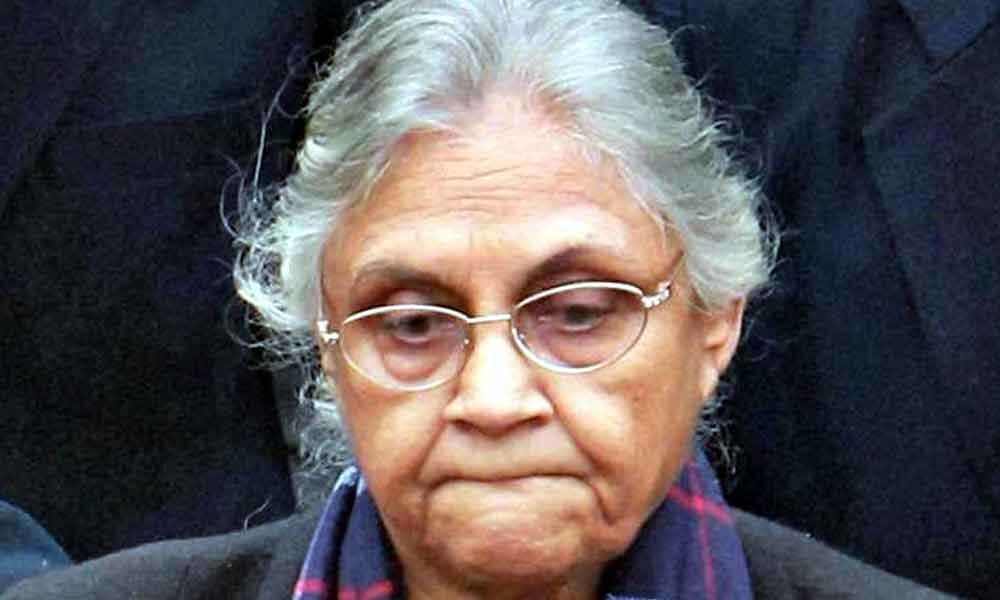Live
- Anantha Lakshmi Int’l School celebrates Sankranti
- Mukkoti Ekadasi observed with religious fervour
- Officials instructed to solve land issues at once
- Alyssa Healy ready to keep wickets for Australia in Ashes series opener
- Illegal sand mining intensifies along Tungabhadra river
- Rain lashes part of Rajasthan, more in store today
- Kerala parents can now monitor their child's academic progress in state-run schools
- IT sector stands out in challenging week for Indian equities
- DTO warns private buses against excess fare
- Mukkoti Ekadasi festivities on a grand scale
Just In
Sheila Dikshit: The affable politician who gave Delhi its modern look


Sheila Dikshit was handpicked by Rajiv Gandhi to be part of his council of ministers after he became the prime minister in 1984.
NEW DELHI: Sheila Dikshit was one of the tallest leaders of the Congress who had the distinction of being Delhi's longest-serving chief minister and giving the national capital Delhi its modern look.
A warm and affable politician, she was a loyalist of the Gandhi family.
She was handpicked by Rajiv Gandhi to be part of his council of ministers after he became the prime minister in 1984.
She represented the Kannauj Lok Sabha seat then.
For her, politics was not only about jousting for power but also about bonding with people and getting re-energised in the process.
Born in Kapurthala in Punjab to a non-political family in 1938, Dikshit did her schooling from Convent of Jesus and Mary School in the capital and graduated from Miranda House, University of Delhi.
She was married in July 1962 to bureaucrat Vinod Dikshit, whose father Uma Shankar Dikshit was a loyalist of Jawaharlal Nehru and served as a minister in Indira Gandhi's cabinet in 1971 and later became Governor of Karnataka and West Bengal.
As the longest-serving woman chief minister who ruled the city-state for three consecutive terms from 1998 to 2013, Dikshit ushered in an era of all-round development that transformed Delhi into a world-class capital.
She also initiated green reforms in public transport sector successfully accomplishing the shift from polluting vehicles to a CNG based fleet.
Known for a string of development works throughout her 15-year stint as Delhi chief minister, Dikshit fastened the flagship Delhi Metro project, oversaw the creation of a network of flyovers in a city stressed with high population density and heavy traffic and also led the phasing out of the killer blue line buses, that had claimed several lives on the roads.
Her largely glorious legacy in Delhi was, however, marred by the CWG scam as the BJP accused her of large scale corruption in several development contracts approved to meet the 2010 Commonwealth Games deadlines.
Dikshit's super political run in Delhi ended in 2013 at the hands of AAP founder Arvind Kejriwal who defeated her in assembly polls.
Kejriwal, the product of the anti-corruption movement led by Anna Hazare succeeded Dikshit as Delhi chief minister.
She sailed through many storms in her long political innings and sought to steer the faction-ridden party out of oblivion after she was made the Delhi Congress chief ahead of assembly polls.
She was again made the Delhi Congress chief just ahead of Lok Sabha election to take the party out of wilderness, but she herself lost the North East seat in Delhi to BJP's Manoj Tiwari and the party drew a drubbing.
Dikshit stepped in to assist her father-in-law and was noticed by Indira Gandhi, who nominated her first as a member of the Indian delegation to the UN Commission on status of women.
First elected to the Lok Sabha in 1984 from Kannauj of Uttar Pradesh, she served as a Minister under Rajiv Gandhi first as the Minister of State for Parliamentary Affairs and later as a Minister of State in the Prime Minister's office.
In 1989, she lost the elections from Kannauj.
Dikshit spent years in wilderness after Rajiv Gandhi's death and returned to the mainstream only after Sonia became the party chief.
She was also projected as chief ministerial candidate in Uttar Pradesh, ahead of 2017 assembly polls, but had to withdraw after the Congress tied up with the Samajwadi Party.
She also served as governor of Kerala from 2013-14.

© 2025 Hyderabad Media House Limited/The Hans India. All rights reserved. Powered by hocalwire.com






